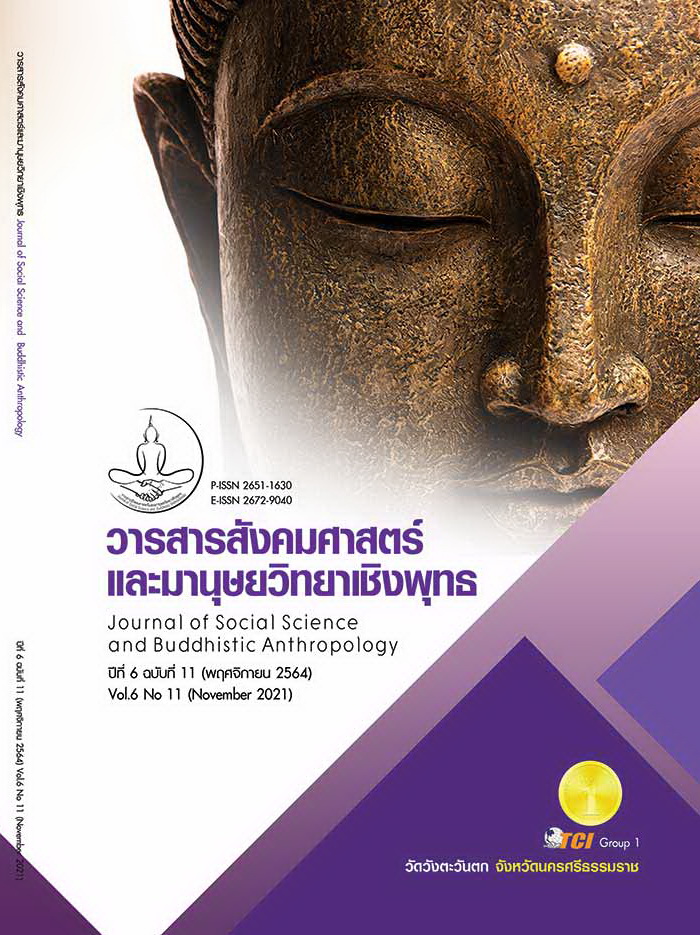THE CAUSAL FACTORS AFFECTING THE STANDARD MARK EQUITY AND THE ORGANIZATIONS PERFORMANCE OF THE CONSUMER - PACKAGED GOODS (CPG) INDUSTRY
Keywords:
Service Marketing Mix, Integrated Marketing Communications, Customer Relationship Management, Standard Mark Equity, Organization Performance of The Consumer - Packaged Goods (CPG) IndustryAbstract
The objectives of this research article were 1) to study the factors of the service marketing mix, integrated marketing communications and customer relationship management that effected on standard mark equity and the organization performance of the Consumer - Packaged Goods (CPG) Industry in Thailand 2) to study the influence of the service marketing mix, integrated marketing communications and customer relationship management that effected on standard mark equity and the organization performance of the Consumer - Packaged Goods (CPG) Industry in Thailand and 3) to construct the causal model of standard mark equity in Thailand. The research uses a mixed method approach by using 440 questionnaires measuring 5 - point Likert scale with Cronbach’s alpha coefficient = 0.98 from entrepreneurs of the Consumer - Packaged Goods (CPG) Industry in Thailand. Data analysis were conducted by LISREL to construct a structural equation modeling (SEM), together with content analysis of in - depth interview, in order to confirm the results. The results showed that the service marketing mix integrated marketing communications and customer relationship management presented positive effect to standard mark equity and the organization performance of the Consumer - Packaged Goods (CPG) Industry in Thailand. Moreover, the results extracted were /df = 1.238, CFI = 1.00, GFI = 0.98, AGFI = 0.94, RMSEA = 0.023 and SRMR = 0.029. Which explained good fit of the model. Thus, a causal model of standard mark equity in Thailand was affirmative.
References
กรมการค้าภายใน กองชั่งตวงวัด. (2563). สถิติผู้ประกอบการในอุตสาหกรรมสินค้าอุปโภคบริโภคที่อยู่ในรูปสินค้า หีบห่อ. เรียกใช้เมื่อ 30 ธันวาคม 2563 จาก http://cbwm.dit.go.th/Package/MerchantPackaging.aspx
วิชิต อู่อ้น. (2553). การวิจัยและการสืบค้นข้อมูลทางธุรกิจ. กรุงเทพมหานคร: มหาวิทยาลัยศรีปทุม.
สำนักงานเลขานุการของคณะกรรมการยุทธศาสตร์ชาติ. (2561). ยุทธศาสตร์ชาติ พ.ศ. 2561 - 2580. (พิมพ์ครั้งที่ 1). สำนักงานเลขานุการของคณะกรรมการยุทธศาสตร์ชาติ: กรุงเทพมหานคร.
Al-Azzam, A. F. M. (2016). The Impact of Customer Relationship Management on Hotels Performance in Jordan. International Journal of Business and Social Science, 7(4), 200-210.
Anabila, P. (2020). Integrated marketing communications, brand equity, and business performance in micro - finance institutions: An emerging market perspective. Journal of Marketing Communications, 26(3), 229-242.
Bertalanffy, L. V. (1968). General system theory: Foundations, Development, Applications. New York: George Braziller.
Brierley, S. (2002). The Advertising Handbook. London: Routledge.
Chepkwony, D. et al. (2018). Influence of Brand Equity on Financial Performance of Mobile Telecommunication Firms in Nairobi, Kenya. International Journal of Economics, Commerce and Management, VI (9), 487-531.
Clifton, R. et al. (2003). BRANDS AND BRANDING. London: Profile Books Ltd.
ElKordy, M. (2014). The Impact of CRM Capability Dimensions on Organizational Performance. European Journal of Business and Social Sciences, 2(10), 128-146.
Gonzalo, M.-G. et al. (2018). Brand Equity and Business Performance in Family and Non - Family Mexican Small Business. International Journal of Business and Management, 13(10), 182-191.
Hilal, M. I. M. (2019). The Effects of Services Marketing Mix Elements on Brand Equity and Customer Response of Tourists Hotels in the East Coast of Sri Lanka. International Journal of Innovative Technology and Exploring Engineering (IJITEE), 8(11S2), 249-259.
Jemutai, C. R. & Wambua, P. P. (2016). Integrated Marketing Communication and Performance of Kenya Post and Savings Bank. Social Sciences, 5(3), 37-49.
Lingavel, D. (2015). Impact of Customer Relationship Management on Brand Equity: Private Hospitals in Jaffna. European Journal of Business and Management, 7(4), 69-79.
Mac-Kingsley, I. & Pokubo, I. M. (2019). Marketing Mix Strategies Performance: A Study of in SMEs in Rivers State of Nigeria. World Journal of Entrepreneurial Development Studies, 3(1), 32-39.
Majumdar, R. (2004). Product Management in India. New Delhi: Prentice Hall India Pvt.
Mohan, B. C. & Sequeira, A. H. (2016). The impact of customer - based brand equity on the operational performance of FMCG companies in India. IIMB Management Review, 28(1), 13-19.
Mongkol, K. (2014). Integrated Marketing Communication to Increase Brand Equity: The Case of a Thai Beverage Company. International Journal of Trade, Economics and Finance, 5(5), 445-448.
Obinwanne, C. O. & Ukabuilu, E. N. (2019). Utilization of Integrated Marketing Communication Tools for Brand Recognition and Sales in Hotels. Journal of Hotel Management and Tourism Research, 4(1), 29-38.
Rahmah, K. et al. (2018). The effect of brand equity, marketing mix, and lifestyle toward purchase decision at coffee shop in BOGOR. Journal of Consumer Sciences, 03(02), 01-15.
Shriedeh, F. & Abdghani, N. H. (2016). Impact of Innovation on the Relationship between Customer Relationship Management and Brand Equity in the Medical Tourism of Jordan. Journal of Research in Business, Economics and Management, 7(4), 1150-1158.
Slaughter, S. & Rhoades, G. (2004). Academic capitalism and the new economy: Markets, state, and higher education. Baltimore: Johns Hopkins University Press.
Yoo, B. et al. (2000). An Examination of Selected Marketing Mix Elements and Brand Equity. Journal of the Academy of Marketing Science, 28(2), 195-211.








